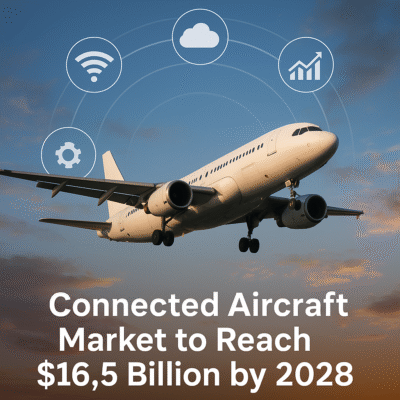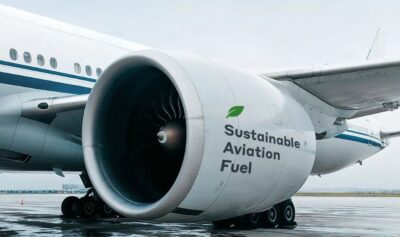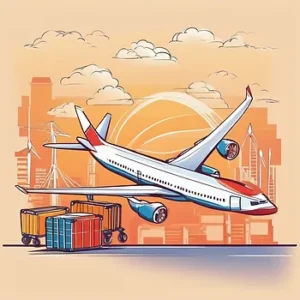Category: News
The Sky Gets Smarter: Connected Aircraft Market Set to Hit $16.5 Billion by 2028
The skies are getting smarter. A digital revolution is unfolding above us, with connected aircraft at the heart of aviation’s transformation. Projected to reach $16.5 billion by 2028, this market is redefining how we fly, operate, and experience air travel. A smart aircraft is more than a flying machine — it’s a data hub in motion.

What Is a Connected Aircraft?
A connected aircraft integrates advanced communication technologies to transmit data between the aircraft, ground systems, and satellite networks in real-time. This ecosystem enables continuous information flow across various stakeholders — pilots, air traffic control, maintenance teams, and even passengers.
Key connectivity systems include:
Satellite Communications (SATCOM)
*Air-to-ground connectivity
*Internet of Things (IoT) sensors
*AI and data analytics platforms
*Flight and crew management systems
Market Growth Drivers
The growth of connected aircraft is not just about faster Wi-Fi — it’s about building a smart aviation ecosystem where every aircraft becomes a real-time decision-making node. Several factors are contributing to this market’s impressive CAGR:
1. Demand for Real-Time Operational Efficiency
Airlines are increasingly leveraging real-time data from engines, avionics, and environmental sensors to optimize fuel efficiency, reduce turnaround times, and minimize delays.
2. Enhanced Passenger Experience
Wi-Fi at 35,000 feet is now expected. Passengers want uninterrupted connectivity for work, entertainment, and communication, driving demand for better bandwidth and seamless onboard services.
3. Predictive Maintenance & Safety
Connected aircraft enable predictive maintenance by continuously transmitting engine health data and system diagnostics, allowing ground teams to preemptively address issues. This not only enhances safety but also reduces aircraft downtime.
4. Regulatory Push & Government Initiatives
Aviation authorities globally are encouraging digital modernization and better surveillance capabilities, particularly in remote regions. Programs like the FAA’s NextGen and Europe’s SESAR are accelerating connectivity adoption.
5. Defense and Military Applications
The defense sector’s need for secure, high-speed airborne communication systems is also fueling the growth of connected aircraft technologies.
Key Technologies Powering the Shift-
*SATCOM High-speed, global connectivity across transoceanic and remote flights
*AI & Machine Learning Predictive maintenance, fuel optimization, decision support
*IoT Sensors Real-time tracking of aircraft systems and environmental conditions
*5G & Edge Computing Faster data processing for high-throughput aircraft systems
*Blockchain Secure, tamper-proof aircraft maintenance and parts tracking
Market Outlook by 2028
North America remains the largest market due to early adoption and strong aviation infrastructure.
Asia-Pacific is emerging as the fastest-growing region, led by rising air travel demand, fleet modernization, and smart airport investments.
Commercial aviation dominates the market share, but business jets and defense aviation are rapidly catching up.
Top Players in the Market
*Honeywell Aerospace
*Collins Aerospace (Raytheon Technologies)
*Panasonic Avionics
*Thales Group
*Gogo Inc.
*Inmarsat
*Viasat
*SITAONAIR
These companies are not just vendors but partners in digital transformation, offering hardware, software, and integrated connectivity platforms.
Challenges Ahead
Despite the optimistic forecast, the industry faces challenges such as:
High implementation costs, especially for older fleets
Cybersecurity risks due to increased digital exposure
Bandwidth limitations in congested air routes
Regulatory and standardization hurdles across regions
Addressing these challenges will require collaboration among OEMs, airlines, regulators, and tech providers.
The Future: Toward a Fully Digital Sky
The connected aircraft market is a cornerstone of the smart aviation ecosystem. As autonomous flight operations, unmanned aerial systems, and urban air mobility evolve, real-time connectivity will become even more critical. As connected aircraft evolve, we move closer to a world where the sky itself becomes a smart, responsive, data-driven environment. The future of aviation isn’t just airborne — it’s intelligent.
Airlines that invest today in digital infrastructure are not just improving operational efficiency — they are future-proofing their business models.
✈️ Final Thoughts
The connected aircraft market is no longer just about providing inflight Wi-Fi — it’s about enabling intelligent, autonomous, and responsive aviation. With a forecasted market value of $16.5 billion by 2028, we are entering an era where every aircraft is a data center in the sky, fundamentally changing how we fly, operate, and experience air travel.
Stay with us as we explore the technologies that are making our skies smarter — one aircraft at a time. Subscribe for more aviation tech insights.
Sustainable Aviation Fuels: Pioneering the Future of Eco-Friendly Air Travel
Introduction
The aviation industry stands at a pivotal crossroads, grappling with the imperative to reduce its environmental footprint. Sustainable Aviation Fuels (SAF) have emerged as a beacon of hope, offering a pathway to significantly lower carbon emissions and promote greener skies. This article delves into the current landscape of SAF, recent advancements, and the future outlook of this transformative technology.
Understanding Sustainable Aviation Fuels
SAF are renewable fuels derived from various sources such as cooking oil, animal waste fat, agricultural and forestry waste, municipal waste, and even direct carbon capture from the atmosphere. These fuels can be blended with conventional jet fuel and used in existing aircraft engines without modifications. The primary advantage of SAF lies in its potential to reduce lifecycle carbon emissions by up to 80% compared to traditional jet fuel.
Earth.Org
PressReleaseInvestorRelations.com

Recent Developments in SAF Production
In a significant move, Colombia’s state-run energy company, Ecopetrol, announced plans to invest between $500 million and $700 million to construct a SAF production plant at the Barrancabermeja refinery. The facility aims to commence operations by 2030, producing approximately 6,000 barrels of SAF daily. This investment underscores the growing commitment of energy companies to sustainable fuel alternatives.
Reuters
However, the journey towards widespread SAF adoption is not without challenges. Willie Walsh, head of the International Air Transport Association (IATA), recently expressed concerns that the aviation industry’s efforts to achieve net-zero emissions by 2050 are lagging. He emphasized that while airlines have committed to this goal, other stakeholders, including fuel suppliers and aircraft manufacturers, need to contribute more actively.
Reuters
Market Outlook and Challenges
The SAF market is poised for growth, driven by regulatory developments and voluntary commitments. According to SkyNRG’s Sustainable Aviation Fuel Market Outlook 2024, global SAF capacity is projected to reach 17.3 million tonnes by 2030, a 4.0 million tonne increase compared to previous estimates. This surge is largely attributed to policies like ReFuelEU in Europe and voluntary uptake in the United States supported by incentives.
SkyNRG
Despite this optimistic projection, the industry faces hurdles, notably the limited availability and high cost of sustainable feedstocks. The production cost of SAF can be significantly higher than that of conventional jet fuel, posing economic challenges for widespread adoption. Additionally, infrastructure and distribution challenges further complicate the scalability of SAF production.
PressReleaseInvestorRelations.com
The Road Ahead
To accelerate the adoption of SAF, a multifaceted approach is essential:
Policy Support: Governments worldwide must implement supportive policies, including blending mandates, incentives, and carbon pricing mechanisms, to make SAF more economically viable.
PressReleaseInvestorRelations.com
Technological Innovation: Investing in research and development can lead to more efficient production pathways, reducing costs and increasing feedstock availability.
Industry Collaboration: Stakeholders across the aviation value chain, from fuel producers to airlines and aircraft manufacturers, need to collaborate to address infrastructure challenges and create a cohesive strategy for SAF integration.
In conclusion, while Sustainable Aviation Fuels present a promising solution for reducing aviation’s carbon footprint, realizing their full potential requires concerted efforts from industry players, policymakers, and researchers. By addressing current challenges and fostering innovation, the aviation industry can navigate towards a more sustainable and environmentally friendly future.
Asia Pacific airlines: state of the industry; more hurdles in international recovery
As we are nearing the end 2024, Asia Pacific’s airline industry continues to face hurdles on its path to fully recovering international capacity. While capacity is nearing 2019 levels, growth has slowed due to ongoing challenges. This report, based on insights from Adrian Schofield at the CAPA Airline Leader Summit in Hong Kong, explores Asia Pacific’s recovery trends, with a focus on Thailand, China, Japan, Hong Kong, and India, and covers factors like aircraft orders, LCC growth, and upcoming challenges for 2025.

While international air travel has rebounded worldwide, the Asia Pacific region’s recovery rate lags at 94% of 2019 levels, compared to over 100% in regions like Europe and North America. This slower recovery is largely due to delayed border reopening’s, which put Asia Pacific’s rebound on a later timeline.
Since 2022, Asia Pacific has seen steady growth in travel demand, but recovery rates have plateaued in 2024, hovering in the high 80s to low 90s. Year-on-year, international seat availability has increased by 16%, though it only grew 4% in early 2024.
Notably, all top domestic city pairs and six of the top ten international routes are within Asia Pacific, reflecting strong regional demand. However, Thailand, where tourism drives 20% of jobs, still sees visitor numbers 13% below 2019 levels. China, previously Thailand’s largest tourism market, shows a modest 55% recovery in visitor numbers, underscoring Asia Pacific’s gradual but ongoing return to pre-pandemic travel norms.
The recovery gap persists due to slow international demand in key markets like China and Japan, supply chain issues delaying new aircraft deliveries, and macroeconomic and geopolitical challenges impacting demand in some areas.